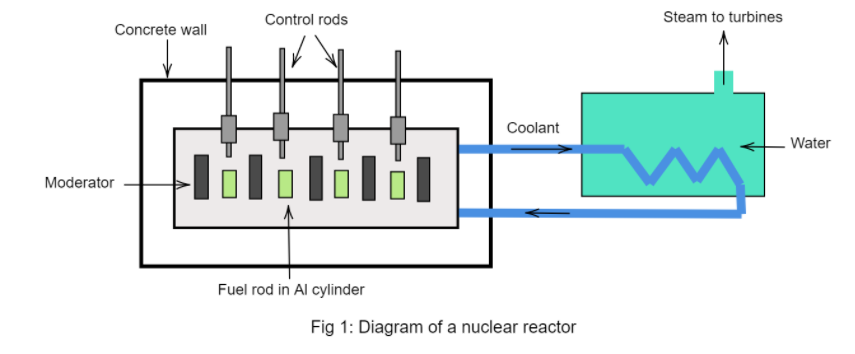
Explain the principle and working of a nuclear reactor with the help of a labelled diagram.
Answer
511.3k+ views
Hint: The nuclear reactor is a device which produces an enormous amount of energy by controlled chain reaction. Sample nuclear reaction used in nuclear reactor:
$_0^1n + _{92}^{235}U \to _{56}^{141}Ba + _{36}^{92}U + 3_0^1n + {\text{Energy}}$
Complete answer:
Principle:
A nuclear reactor works on the principles of generating great amounts of energy by achieving controlled chain reaction of Uranium $^{238}U$ enriched with $^{235}U$. This is made possible by:
1. Slowing down the fission neutrons to thermal neutrons using a moderator. Thermal neutrons initiate the fission of $^{235}U$.
2. By using control rods of a material which can absorb neutrons. This is important to control the rate of reaction and maintain it so that the value of neutron multiplication factor K remains 1.
Working:
- Fuel rods are filled with Uranium. These are placed in aluminum cylinders.
- In between the fuel cylinders, the graphite moderator is placed.
- Control rods made up of Cadmium, Beryllium or Boron are placed in the holes of the block of graphite
- When neutrons undergo fission, fast neutrons are released. On passing through the surrounding graphite moderators, these fast neutrons lose their energy and become thermal neutrons.
- $^{235}U$ captures these thermal neutrons.
- Coolants such as water are converted to steam through this heat energy.
- This steam is then used to rotate a steam turbine which drives a generator to produce electricity.
Diagram:

Additional information:
In a Nuclear reactor station use of cold water sink after passage from turbine is necessary not only to maintain continuous flow of water into the channel but to absorb enormous heat release as it can completely change the chemical behavior of gases above and around the reactor in a radius of 10-15km.
Note: Energy evolved in the above nuclear reaction is very huge and it comes out with radiations as well in order to contain radiation, absorbers like lead are used. It is also good to note that energy is so immense that it becomes necessary to control the evolution of energy by breaking the reaction into steps. We, therefore, say nuclear reactors have controlled chain reaction as its most important stage.
$_0^1n + _{92}^{235}U \to _{56}^{141}Ba + _{36}^{92}U + 3_0^1n + {\text{Energy}}$
Complete answer:
Principle:
A nuclear reactor works on the principles of generating great amounts of energy by achieving controlled chain reaction of Uranium $^{238}U$ enriched with $^{235}U$. This is made possible by:
1. Slowing down the fission neutrons to thermal neutrons using a moderator. Thermal neutrons initiate the fission of $^{235}U$.
2. By using control rods of a material which can absorb neutrons. This is important to control the rate of reaction and maintain it so that the value of neutron multiplication factor K remains 1.
Working:
- Fuel rods are filled with Uranium. These are placed in aluminum cylinders.
- In between the fuel cylinders, the graphite moderator is placed.
- Control rods made up of Cadmium, Beryllium or Boron are placed in the holes of the block of graphite
- When neutrons undergo fission, fast neutrons are released. On passing through the surrounding graphite moderators, these fast neutrons lose their energy and become thermal neutrons.
- $^{235}U$ captures these thermal neutrons.
- Coolants such as water are converted to steam through this heat energy.
- This steam is then used to rotate a steam turbine which drives a generator to produce electricity.
Diagram:

Additional information:
In a Nuclear reactor station use of cold water sink after passage from turbine is necessary not only to maintain continuous flow of water into the channel but to absorb enormous heat release as it can completely change the chemical behavior of gases above and around the reactor in a radius of 10-15km.
Note: Energy evolved in the above nuclear reaction is very huge and it comes out with radiations as well in order to contain radiation, absorbers like lead are used. It is also good to note that energy is so immense that it becomes necessary to control the evolution of energy by breaking the reaction into steps. We, therefore, say nuclear reactors have controlled chain reaction as its most important stage.
Recently Updated Pages
Master Class 12 Business Studies: Engaging Questions & Answers for Success

Master Class 12 Social Science: Engaging Questions & Answers for Success

Master Class 12 English: Engaging Questions & Answers for Success

Master Class 12 Chemistry: Engaging Questions & Answers for Success

Class 12 Question and Answer - Your Ultimate Solutions Guide

Master Class 12 Economics: Engaging Questions & Answers for Success

Trending doubts
What are the major means of transport Explain each class 12 social science CBSE

Which are the Top 10 Largest Countries of the World?

Draw a labelled sketch of the human eye class 12 physics CBSE

How much time does it take to bleed after eating p class 12 biology CBSE

Explain sex determination in humans with line diag class 12 biology CBSE

When was the first election held in India a 194748 class 12 sst CBSE




